 Solar Neutrinos Before and After Neutrino2004
Solar Neutrinos Before and After Neutrino2004
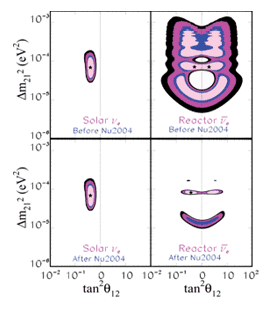 |
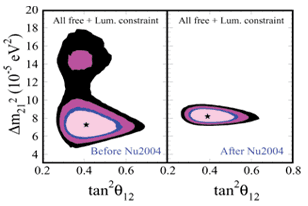 |
 A Road Map to Solar Neutrino Fluxes,
Neutrino Oscillation Parameters, and Tests for New Physics
A Road Map to Solar Neutrino Fluxes,
Neutrino Oscillation Parameters, and Tests for New Physics
 Solar Models and Solar Neutrino Oscillations
Solar Models and Solar Neutrino Oscillations
 What Can We Learn from Neutrinoless Double
Beta Decay Experiments?
What Can We Learn from Neutrinoless Double
Beta Decay Experiments?
 Solar Neutrinos Before and After KamLAND
Solar Neutrinos Before and After KamLAND

Anti-neutrino oscillation parameters regions allowed by KamLAND. |

Matter effects in the KamLAND reactor experiment. |

After: Solar neutrino oscillations after KamLAND. |

The Sterile-Total flux correlation. |
 Does the Sun Shine by pp or CNO Fusion Reactions?
Does the Sun Shine by pp or CNO Fusion Reactions?
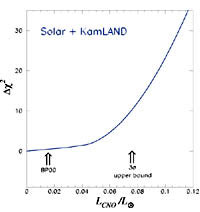 (7.3% including the recent KamLAND
measurements) to the amount of energy that the Sun produces via the
CNO fusion cycle, which is an order of magnitude improvement upon the
previous limit. New experiments are required to detect CNO neutrinos
corresponding to the 1.5% of the solar luminosity that the standard
solar model predicts is generated by the CNO cycle.
(7.3% including the recent KamLAND
measurements) to the amount of energy that the Sun produces via the
CNO fusion cycle, which is an order of magnitude improvement upon the
previous limit. New experiments are required to detect CNO neutrinos
corresponding to the 1.5% of the solar luminosity that the standard
solar model predicts is generated by the CNO cycle.
 A Solution of the Solar-Neutrino Problem
A Solution of the Solar-Neutrino Problem
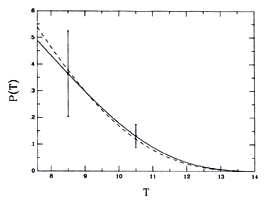 solar models shows that the explanation
of the solar-neutrino problem probably requires physics beyond the
standard electroweak model with zero neutrino masses. The
experimental results, including the shape of the electron-recoil
energy spectrum measured by Kamiokande, are in excellent agreement
with a nonadiabatic solution of the Mikheyev-Smirnov -Wolfenstein
effect, yielding a neutrino mass difference of
Δm2 = 1 x
10-8sin
solar models shows that the explanation
of the solar-neutrino problem probably requires physics beyond the
standard electroweak model with zero neutrino masses. The
experimental results, including the shape of the electron-recoil
energy spectrum measured by Kamiokande, are in excellent agreement
with a nonadiabatic solution of the Mikheyev-Smirnov -Wolfenstein
effect, yielding a neutrino mass difference of
Δm2 = 1 x
10-8sin
 Before and After: How has the SNO NC
measurement changed things?
Before and After: How has the SNO NC
measurement changed things?
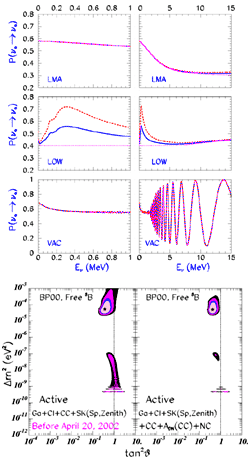
 If sterile neutrinos exist, how can one
determine the total solar neutrino fluxes?
If sterile neutrinos exist, how can one
determine the total solar neutrino fluxes?
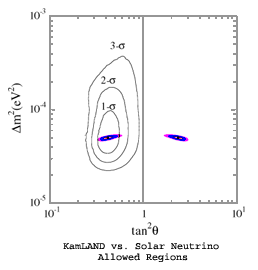
 How Accurately Can One Test CPT
Conservation with Reactor and Solar Neutrino Experiments?
How Accurately Can One Test CPT
Conservation with Reactor and Solar Neutrino Experiments?
 Robust signatures of solar neutrino
oscillation solutions
Robust signatures of solar neutrino
oscillation solutions
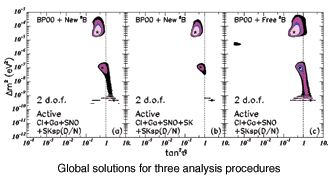 identifying signatures that select specific neutrino oscillation
parameters, we test the robustness of global oscillation solutions
that fit all the available solar and reactor experimental data. We use
three global analysis strategies previously applied by different
authors and also determine the sensitivity of the oscillation
solutions to the critical nuclear fusion cross section,
S17(0), for the production of 8B. The
favored solutions are LMA, LOW, and VAC in order of g.o.f. The neutral
current to charged current ratio for SNO is predicted to be 3.5 +- 0.6
(1 sigma), which is separated from the no-oscillation value of 1.0 by
much more than the expected experimental error. The predicted range of
the day-night difference in charged current rates is (8.2 +- 5.2)% and
is strongly correlated with the day-night effect for neutrino-electron
identifying signatures that select specific neutrino oscillation
parameters, we test the robustness of global oscillation solutions
that fit all the available solar and reactor experimental data. We use
three global analysis strategies previously applied by different
authors and also determine the sensitivity of the oscillation
solutions to the critical nuclear fusion cross section,
S17(0), for the production of 8B. The
favored solutions are LMA, LOW, and VAC in order of g.o.f. The neutral
current to charged current ratio for SNO is predicted to be 3.5 +- 0.6
(1 sigma), which is separated from the no-oscillation value of 1.0 by
much more than the expected experimental error. The predicted range of
the day-night difference in charged current rates is (8.2 +- 5.2)% and
is strongly correlated with the day-night effect for neutrino-electron
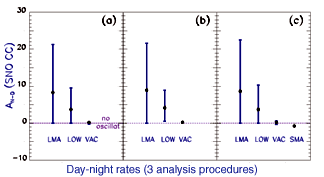 scattering. A measurement by SNO of either a NC to CC ratio > 3.3
or a day-night difference > 10%, would favor a small region of the
currently allowed LMA neutrino parameter space. The global oscillation
solutions predict a 7Be neutrino-electron scattering rate
in BOREXINO and KamLAND in the range 0.66 +- 0.04 of the BP00 standard
solar model rate, a prediction which can be used to test both the
scattering. A measurement by SNO of either a NC to CC ratio > 3.3
or a day-night difference > 10%, would favor a small region of the
currently allowed LMA neutrino parameter space. The global oscillation
solutions predict a 7Be neutrino-electron scattering rate
in BOREXINO and KamLAND in the range 0.66 +- 0.04 of the BP00 standard
solar model rate, a prediction which can be used to test both the
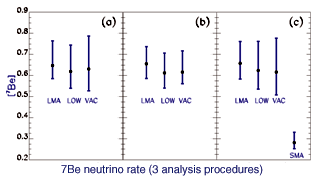 solar model and the neutrino oscillation theory. Only the LOW solution
predicts a large day-night effect(< 42%) in BOREXINO and KamLAND.
For
the reactor KamLAND experiment, the LMA solution predicts a charged
current rate relative to the standard model of 0.44^{+0.22}_{-0.07}
(1 sigma) [0.44^{+0.29}_{-0.17} (3 sigma)], Ethreshold = 1.22
MeV, with a somewhat larger allowed range for a higher energy
threshold.
solar model and the neutrino oscillation theory. Only the LOW solution
predicts a large day-night effect(< 42%) in BOREXINO and KamLAND.
For
the reactor KamLAND experiment, the LMA solution predicts a charged
current rate relative to the standard model of 0.44^{+0.22}_{-0.07}
(1 sigma) [0.44^{+0.29}_{-0.17} (3 sigma)], Ethreshold = 1.22
MeV, with a somewhat larger allowed range for a higher energy
threshold.
 How many sigmas is the solar neutrino effect?
How many sigmas is the solar neutrino effect?
 (formally 99% C.L.). Considering just SNO and Super-Kamiokande, the
discrepancy is at the 3.3
(formally 99% C.L.). Considering just SNO and Super-Kamiokande, the
discrepancy is at the 3.3 level (10-3
C.L.). If all six experiments are fit simultaneously, the formal
discrepancy increases to 4
level (10-3
C.L.). If all six experiments are fit simultaneously, the formal
discrepancy increases to 4 (7 x 10-5
C.L.). If the relative scaling in temperature of the nuclear reactions
that produce 7Be and 8B neutrinos is taken into
account, the formal discrepancy is at the 7.4
(7 x 10-5
C.L.). If the relative scaling in temperature of the nuclear reactions
that produce 7Be and 8B neutrinos is taken into
account, the formal discrepancy is at the 7.4 level.
level.
 The luminosity constraint on solar neutrino
fluxes
The luminosity constraint on solar neutrino
fluxes
 Global Analysis of Solar Neutrino Oscillations Including SNO
CC Measurement
Global Analysis of Solar Neutrino Oscillations Including SNO
CC Measurement
 ; three sterile neutrino
solutions (Just So2, SMA, and VAC) are allowed at 3
; three sterile neutrino
solutions (Just So2, SMA, and VAC) are allowed at 3 . The
goodness of fit is satisfactory for all eight solutions. We also
investigate the robustness of the allowed solutions by carrying out
global analyses with and without: 1) imposing solar model constraints
on the 8B neutrino flux, 2) including the Super-Kamiokande
spectral energy distribution and day-night data, 3) including a
continuous mixture of active and sterile neutrinos, 4) using an
enhanced CC cross section for deuterium (due to radiative
corrections), and 5) an optimistic, hypothetical reduction by a factor
of three of the error of the SNO CC rate. For every analysis strategy
used in this paper, the most favored solutions all involve large
mixing angles: LMA, LOW, or VAC. The favored solutions are robust,
but the existence at 3
. The
goodness of fit is satisfactory for all eight solutions. We also
investigate the robustness of the allowed solutions by carrying out
global analyses with and without: 1) imposing solar model constraints
on the 8B neutrino flux, 2) including the Super-Kamiokande
spectral energy distribution and day-night data, 3) including a
continuous mixture of active and sterile neutrinos, 4) using an
enhanced CC cross section for deuterium (due to radiative
corrections), and 5) an optimistic, hypothetical reduction by a factor
of three of the error of the SNO CC rate. For every analysis strategy
used in this paper, the most favored solutions all involve large
mixing angles: LMA, LOW, or VAC. The favored solutions are robust,
but the existence at 3 of individual sterile
solutions and the active Just So2 solution is sensitive to
the analysis assumptions.
of individual sterile
solutions and the active Just So2 solution is sensitive to
the analysis assumptions.
 Why Do Solar Neutrino Experiments Below 1
MeV?
Why Do Solar Neutrino Experiments Below 1
MeV?
 Solar
neutrinos: global analysis and implications for SNO
Solar
neutrinos: global analysis and implications for SNO
 range allowed by the standard
solar model. We discuss the implications for SNO of a low mass,
range allowed by the standard
solar model. We discuss the implications for SNO of a low mass,
 m2 ~ 6 x 10-12 eV2, vacuum oscillation
solution, previously found by Raghavan, and by Krastev and Petcov, but
absent in recent analyses that included Super-Kamiokande data. For
the SNO experiment, we present refined predictions for the
charged-current rate and the ratio of the neutral-current rate to
charged-current rate. The predicted charged-current rate can be
clearly distinguished from the no-oscillation rate only for the LMA
solution. The predicted ratio of the neutral-current rate to
charged-current rate is distinguishable from the no-oscillation ratio
for the LMA, SMA, LOW, and VAC solutions for active neutrinos.
m2 ~ 6 x 10-12 eV2, vacuum oscillation
solution, previously found by Raghavan, and by Krastev and Petcov, but
absent in recent analyses that included Super-Kamiokande data. For
the SNO experiment, we present refined predictions for the
charged-current rate and the ratio of the neutral-current rate to
charged-current rate. The predicted charged-current rate can be
clearly distinguished from the no-oscillation rate only for the LMA
solution. The predicted ratio of the neutral-current rate to
charged-current rate is distinguishable from the no-oscillation ratio
for the LMA, SMA, LOW, and VAC solutions for active neutrinos.
 Correlations
of Solar Neutrino Observables for SNO
Correlations
of Solar Neutrino Observables for SNO
 SNO:
Predictions for Ten Measurable Quantities
SNO:
Predictions for Ten Measurable Quantities
 from the no-oscillation solution
for all of the currently favored neutrino oscillation solutions. The
best-fit oscillation solutions predict a CC day-night rate difference
between -0.1% and +12.5% and a NC day-night difference < 0.01%. We
present also the predicted range for the first and the second moments of the
charged current electron recoil energy spectrum, the charged current, the
neutral current, and the
from the no-oscillation solution
for all of the currently favored neutrino oscillation solutions. The
best-fit oscillation solutions predict a CC day-night rate difference
between -0.1% and +12.5% and a NC day-night difference < 0.01%. We
present also the predicted range for the first and the second moments of the
charged current electron recoil energy spectrum, the charged current, the
neutral current, and the  -e scattering rates, the seasonal dependence of the charged
current rate, and the double ratio of neutrino-electron scattering
rate to charged current rate.
-e scattering rates, the seasonal dependence of the charged
current rate, and the double ratio of neutrino-electron scattering
rate to charged current rate.
 What
Will the First Year of SNO Show?
What
Will the First Year of SNO Show?
 Is
Large Mixing Angle MSW the Solution of the Solar Neutrino Problems?
Is
Large Mixing Angle MSW the Solution of the Solar Neutrino Problems?
 indication of
neutrino oscillations.
indication of
neutrino oscillations.
 Letter from Bruno Pontecorvo in 1972
Letter from Bruno Pontecorvo in 1972
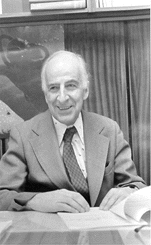 Pontecorvo remarks with regard to the latest results of the chlorine
experiment of Ray Davis: "It starts to be really interesting!
It would be nice if all this will end with something unexpected from the point
of view of particle physics. Unfortunately, it will not be easy to
demonstrate this, even if nature works that way."
Pontecorvo remarks with regard to the latest results of the chlorine
experiment of Ray Davis: "It starts to be really interesting!
It would be nice if all this will end with something unexpected from the point
of view of particle physics. Unfortunately, it will not be easy to
demonstrate this, even if nature works that way."
This letter is published in the proceedings of the 23rd Johns
Hopkins Workshop on Current Problems in Particle Theory,
Neutrinos in the Next Millennium, Baltimore, June 10-12, 1999
(World Scientific, Singapore 2000), pp. 91-112.
 Where
do we stand with solar neutrino oscillations?
Where
do we stand with solar neutrino oscillations?
 Do hep neutrinos affect the solar neutrino energy spectrum?
Do hep neutrinos affect the solar neutrino energy spectrum?
 4He + e+ +
4He + e+ +  e,
the `hep'
reaction, is
e,
the `hep'
reaction, is  20 times larger than the best (but uncertain)
theoretical estimates, then
this reaction could significantly influence the electron energy
spectrum produced by solar neutrino interactions and measured
in the SuperKamiokande, SNO, and
ICARUS experiments.
We compare predicted energy spectra for different assumed hep
fluxes and different neutrino oscillation scenarios
with the observed SuperKamiokande spectrum. The spectra with enhanced
hep contributions provide better fits to the SuperKamiokande data.
20 times larger than the best (but uncertain)
theoretical estimates, then
this reaction could significantly influence the electron energy
spectrum produced by solar neutrino interactions and measured
in the SuperKamiokande, SNO, and
ICARUS experiments.
We compare predicted energy spectra for different assumed hep
fluxes and different neutrino oscillation scenarios
with the observed SuperKamiokande spectrum. The spectra with enhanced
hep contributions provide better fits to the SuperKamiokande data.
 Does the Sun Appear
Brighter at Night in Neutrinos?
Does the Sun Appear
Brighter at Night in Neutrinos?
 -e interactions in the
earth that
regenerate electron type neutrinos from mu or
tau neutrinos.
We show that the first two
moments of the zenith-angle distribution are more
sensitive to the small mixing angle MSW solution than
the conventionally studied day-night
asymmetry. We present iso-sigma contours that illustrate the potential
of Super-Kamiokande, SNO, BOREXINO, ICARUS and HERON/HELLAZ for
detecting
the earth regeneration effect at their actual locations
(and at the equator).
MSW solutions
favored by the four pioneering solar neutrino experiments
predict characteristic distortions for Super-Kamiokande, SNO,
BOREXINO, and ICARUS
that range from being
unmeasurably small to
> 5
-e interactions in the
earth that
regenerate electron type neutrinos from mu or
tau neutrinos.
We show that the first two
moments of the zenith-angle distribution are more
sensitive to the small mixing angle MSW solution than
the conventionally studied day-night
asymmetry. We present iso-sigma contours that illustrate the potential
of Super-Kamiokande, SNO, BOREXINO, ICARUS and HERON/HELLAZ for
detecting
the earth regeneration effect at their actual locations
(and at the equator).
MSW solutions
favored by the four pioneering solar neutrino experiments
predict characteristic distortions for Super-Kamiokande, SNO,
BOREXINO, and ICARUS
that range from being
unmeasurably small to
> 5 (stat)
after only a few years of observations.
(stat)
after only a few years of observations.
 Neutrino Oscillations and
Moments of Electron Spectra
Neutrino Oscillations and
Moments of Electron Spectra
 m2, sin22
m2, sin22 ) parameter space.
) parameter space.
 Tests of Electron Flavor
Conservation with the Sudbury Neutrino Observatory
Tests of Electron Flavor
Conservation with the Sudbury Neutrino Observatory
 What Can Be Learned by
Measuring the Fluxes of the 7Be
What Can Be Learned by
Measuring the Fluxes of the 7Be
 How Does the Sun Shine?
How Does the Sun Shine?
 How Well Do We (and Will We) Know Solar Neutrino Fluxes and Oscillation Parameters?
How Well Do We (and Will We) Know Solar Neutrino Fluxes and Oscillation Parameters?
 Do
solar-neutrino experiments imply new physics?
Do
solar-neutrino experiments imply new physics?
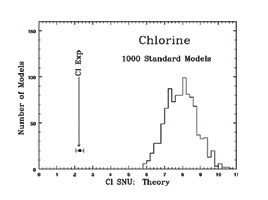 None of the 1000 solar models in a full Monte Carlo simulation is
consistent with the results of the chlorine or the Kamiokande
experiments. Even if the solar models are forced artifically to
have a 8B neutrino flux in agreeement with the Kamiokande
experiment, none of the fudged models agrees with the chlorine
observations. The GALLEX and SAGE experiments, which currently
have large statistical uncertainties, differ from the predictions
of the standard solar model by 2
None of the 1000 solar models in a full Monte Carlo simulation is
consistent with the results of the chlorine or the Kamiokande
experiments. Even if the solar models are forced artifically to
have a 8B neutrino flux in agreeement with the Kamiokande
experiment, none of the fudged models agrees with the chlorine
observations. The GALLEX and SAGE experiments, which currently
have large statistical uncertainties, differ from the predictions
of the standard solar model by 2  and 3
and 3  ,
respectively.
,
respectively.
 Back to John Bahcall (Recent Preprints and Reprints)
Back to John Bahcall (Recent Preprints and Reprints)